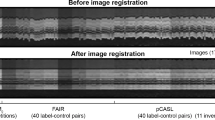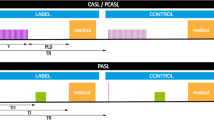Abstract
Object
Arterial spin labelling (ASL) can be used to measure renal perfusion non-invasively. The aim of this study was to determine the repeatability of this technique in healthy kidneys to vindicate its use in clinic.
Materials and methods
Two groups of healthy volunteers were imaged two different days to assess intra- and inter-session repeatability. Oblique-coronal data volumes were acquired on a 1.5 T scanner with a dedicated abdominal 32-channel body phased array coil. ASL was performed using a multi-TI FAIR labelling scheme and 3D GRASE imaging module. Background suppression and respiratory triggering were used. T1 maps of the kidney were acquired using the same sequence with background suppression disabled.
Results
For the group with multiple intra-session ASL measurements, the average cortical perfusion was 197 mL min−1100 g−1 and average cortical T1 was 1265 ms. For both perfusion and T1 the variation shown by the within-subject standard deviation (SDws) (14.6 mL min−1100 g−1 and 33.4 ms) and coefficient of variation (CVws) (7.52 and 2.69%, respectively) was small for all the analyses carried out. Bland–Altman plots were also used to visualise the variation between the same parameters collected from the different scanning sessions in both groups, and demonstrated good reproducibility.
Conclusion
We have shown that in healthy volunteers, ASL parameters are repeatable over a short and long period. This supports the overall aim of using ASL in the clinic to assess longitudinal renal perfusion changes in patients.






Similar content being viewed by others
References
Neimatallah MA, Dong Q, Schoenberg SO, Cho KJ, Prince MR (1999) Magnetic resonance imaging in renal transplantation. J Magn Reson Imaging 10(3):357–368
Szolar DH, Preidler K, Ebner F, Kammerhuber F, Horn S, Ratschek M, Ranner G, Petritsch P, Horina JH (1997) Functional magnetic resonance imaging of human renal allografts during the post-transplant period: preliminary observations. Magn Reson Imaging 15(7):727–735
Haufe SE, Riedmuller K, Haberkorn U (2006) Nuclear medicine procedures for the diagnosis of acute and chronic renal failure. Nephron Clin Pract 103(2):c77–c84
Peters AM, Brown J, Hartnell GG, Myers MJ, Haskell C, Lavender JP (1987) Non-invasive measurement of renal blood flow with 99mTc DTPA: comparison with radiolabelled microspheres. Cardiovasc Res 21(11):830–834
Golay X, Hendrikse J, Lim TC (2004) Perfusion imaging using arterial spin labeling. Top Magn Reson Imaging 15(1):10–27
Petersen ET, Zimine I, Ho YC, Golay X (2006) Non-invasive measurement of perfusion: a critical review of arterial spin labelling techniques. Br J Radiol 79(944):688–701
Buxton RB (2002) Introduction to functional magnetic resonance imaging. Cambridge University Press, Cambridge
Martirosian P, Boss A, Schraml C, Schwenzer NF, Graf H, Claussen CD, Schick F (2010) Magnetic resonance perfusion imaging without contrast media. Eur J Nucl Med Mol Imaging 37(Suppl 1):S52–S64
Roberts DA, Detre JA, Bolinger L, Insko EK, Lenkinski RE, Pentecost MJ, Leigh JS Jr (1995) Renal perfusion in humans: MR imaging with spin tagging of arterial water. Radiology 196(1):281–286
Chen Q, Siewert B, Bly BM, Warach S, Edelman RR (1997) STAR-HASTE: perfusion imaging without magnetic susceptibility artifact. Magn Reson Med 38:404–408
Karger N, Biederer J, Lusse S, Grimm J, Steffens J, Heller M, Gluer C (2000) Quantitation of renal perfusion using arterial spin labeling with FAIR-UFLARE. Magn Reson Imaging 18(6):641–647
Martirosian P, Klose U, Mader I, Schick F (2004) FAIR True-FISP perfusion imaging of the kidneys. Magn Reson Med 51:353–361
De Bazelaire C, Rofsky NM, Duhamel G, Michaelson MD, George D, Alsop DC (2005) Arterial spin labeling blood flow magnetic resonance imaging for the characterization of metastatic renal cell carcinoma(1). Acad Radiol 12(3):347–357
Fenchel M, Martirosian P, Langanke J, Giersch J, Miller S, Stauder NI, Kramer U, Claussen CD, Schick F (2006) Perfusion MR imaging with FAIR true FISP spin labeling in patients with and without renal artery stenosis: initial experience. Radiology 238(3):1013–1021
Artz NS, Sadowski EA, Wentland AL, Grist TM, Seo S, Djamali A, Fain SB (2011) Arterial spin labeling MRI for assessment of perfusion in native and transplanted kidneys. Magn Reson Imaging 29(7):74–82
Lanzman RS, Wittsack HJ, Martirosian P, Zgoura P, Bilk P, Kropil P, Schick F, Voiculescu A, Blondin D (2010) Quantification of renal allograft perfusion using arterial spin labeling MRI: initial results. Eur Radiol 20(6):1485–1491
Pedrosa I, Alsop DC, Rofsky NM (2009) Magnetic resonance imaging as a biomarker in renal cell carcinoma. Cancer 115(10 Suppl):2334–2345
Kim SG (1995) Quantification of relative cerebral blood flow change by flow-sensitive alternating inversion recovery (FAIR) technique: application to functional mapping. Magn Reson Med 34:293–301
Song R, Loeffler RB, Hillenbrand CM (2010) Improved renal perfusion measurement with a dual navigator-gated Q2TIPS fair technique. Magn Reson Med 64(5):1352–1359
Wong EC, Buxton RB, Frank LR (1998) Quantitative imaging of perfusion using a single subtraction (QUIPSS and QUIPSS II). Magn Reson Med 39:702–708
Dobbs MS, Woodhouse N, Parker GJ, Naish JH (2010) Renal ASL using multiple inversion time, free breathing STAR-HASTE technique at 3T [abstract]. In: Proceedings of 18th Meeting of ISMRM, p 2676
Buxton RB, Frank LR, Wong EC, Siewert B, Warach S, Edelman RR (1998) A general kinetic model for quantitative perfusion imaging with arterial spin labeling. Magn Reson Med 40(3):383–396
Gardener AG, Francis ST (2010) Multislice perfusion of the kidneys using parallel imaging: image acquisition and analysis strategies. Magn Reson Imaging 63(6):1627–1636
Gunther M, Oshio K, Feinberg DA (2005) Single-shot 3D imaging techniques improve arterial spin labeling perfusion measurements. Magn Reson Med 54(2):491–498
Freeman R (1997) A handbook of nuclear magnetic resonance. Longman Limited, London, p 275
Regan MC, Young LS, Geraghty J, Fitzpatrick JM (1995) Regional renal blood flow in normal and disease states. Urol Res 23(1):1–10
Cheong B, Muthupillai R, Rubin MF, Flamm SD (2007) Normal values for renal length and volume as measured by magnetic resonance imaging. Clin J Am Soc Nephrol 2(1):38–45
Ye FQ, Frank JA, Weinberger DR, McLaughlin AC (2000) Noise reduction in 3D perfusion imaging by attenuating the static signal in arterial spin tagging (ASSIST). Magn Reson Med 44(1):92–100
Bland JM, Altman DG (1996) Measurement error. Br Med J 313(7059):744
Bland JM, Altman DG (1986) Statistical methods for assessing agreement between two methods of clinical measurement. Lancet 1(8476):307–310
Chasis H, Ranges HA, Goldring W, Smith HW (1938) The control of renal blood flow and glomerular filtration in normal man. J Clin Invest 17(5):683–697
Ladefoged J (1966) Measurements of the renal blood flow in man with the 133 xenon wash-out technique. A description of the method. Scand J Clin Lab Invest 18(3):299–315
Miles KA (1991) Measurement of tissue perfusion by dynamic computed tomography. Br J Radiol 64(761):409–412
Kiefer C, Schroth G, Gralla J, Diehm N, Baumgartner I, Husmann M (2009) A feasibility study on model-based evaluation of kidney perfusion measured by means of FAIR prepared true-FISP arterial spin labeling (ASL) on a 3-T MR scanner. Acad Radiol 16(1):79–87
Song R, Loeffler RB, Hillenbrand CM (2011) QUIPSS II with window-sliding saturation sequence (Q2WISE). Magn Reson Med EPub ahead of print. doi:10.1002/mrm.23093
Robson PM, Madhuranthakam AJ, Dai W, Pedrosa I, Rofsky NM, Alsop DC (2009) Strategies for reducing respiratory motion artifacts in renal perfusion imaging with arterial spin labeling. Magn Reson Med 61(6):1374–1387
Artz NS, Sadowski EA, Wentland AL, Djamali A, Grist TM, Seo S, Fain SB (2011) Reproducibility of renal perfusion MR imaging in native and transplanted kidneys using non-contrast arterial spin labeling. J Magn Reson Imaging 33(6):1414–1421
Acknowledgments
The authors would like to thank Dr. Martin King for his valuable discussion, advice and help with the statistical analysis presented in this study. We would also like to thank Dr. Matthias Günther for providing the 3D GRASE ASL pulse sequence. The authors acknowledge Kidney Research UK for part-funding this study of ASL in volunteers.
Author information
Authors and Affiliations
Corresponding authors
Additional information
Marica Cutajar and David L. Thomas joint first authors.
Rights and permissions
About this article
Cite this article
Cutajar, M., Thomas, D.L., Banks, T. et al. Repeatability of renal arterial spin labelling MRI in healthy subjects. Magn Reson Mater Phy 25, 145–153 (2012). https://doi.org/10.1007/s10334-011-0300-9
Received:
Revised:
Accepted:
Published:
Issue Date:
DOI: https://doi.org/10.1007/s10334-011-0300-9




